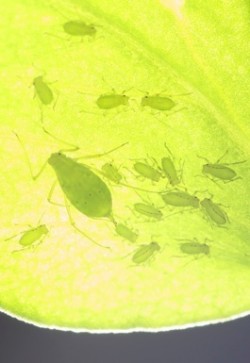
Animals have complex ways of dealing with infection. Most of these constitute the immune system, but animals can do other non-immune things to either protect themselves from getting infected, or to help cope with infection (reviewed here with Ben Parker and others). These adaptations might be particularly important for animals with a weak immune system, like pea aphids. In some earlier work with Nicole Gerardo and Dan Sok I found that aphids will crank up reproduction when they detect signs of infection. This process, known as fecundity compensation or terminal investment, helps to ensure that aphids that have a higher risk of death (i.e. because of parasitism) still have some reproductive fitness.
This process of increasing reproduction makes a lot of sense, but what I wondered about is why don’t aphids do this all the time? Aphids already reproduce very quickly. Just ask anyone who finds them on their roses in spring. But they seem to be able to go faster when they are exposed to signs of risk. Surely an aphid that is permanently on this accelerated reproductive rate would outcompete all the other aphids?
To try and understand the conditions which favour fecundity compensation Gabriel Leventhal, Robert Dünner, and I used a combination of models and experiments. We were particularly interested in seeing if we could find costs of fecundity compensation which could explain why this is a plastic trait. Or, in other words, why don’t they always reproduce this quickly. We found that introducing a delay between exposure to a parasite and the onset of virulence (damage) can lead to the evolution of fecundity compensation in our model, even if there is a cost associated with changing reproduction. These costs need to be small though. Our experiment confirmed fecundity compensation in pea aphids when they are given cues of infection but we couldn’t find any costs associated with the reproductive shift, which this falls in line with the model – that costs of fecundity compensation must be small to evolve. Parasites are one factor that will shorten an aphid’s lifetime, but by no means the only factor. It’s likely that a host of conditions alter reproduction to ensure some fitness, such as changes in plant quality, temperature, or predation risk. Being able to manipulate their reproductive schedule according to risk is probably a valuable adaptation to secure fitness in changeable environments.
This paper will be published in The American Naturalist. An accepted draft of the manuscript can be found here.
